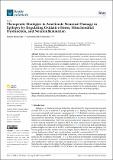Therapeutic Strategies to Ameliorate Neuronal Damage in Epilepsy by Regulating Oxidative Stress, Mitochondrial Dysfunction, and Neuroinflammation
Author(s)
Madireddy, Sahithi; Madireddy, Samskruthi
Downloadbrainsci-13-00784.pdf (1.250Mb)
Publisher with Creative Commons License
Publisher with Creative Commons License
Creative Commons Attribution
Terms of use
Metadata
Show full item recordAbstract
Epilepsy is a central nervous system disorder involving spontaneous and recurring seizures that affects 50 million individuals globally. Because approximately one-third of patients with epilepsy do not respond to drug therapy, the development of new therapeutic strategies against epilepsy could be beneficial. Oxidative stress and mitochondrial dysfunction are frequently observed in epilepsy. Additionally, neuroinflammation is increasingly understood to contribute to the pathogenesis of epilepsy. Mitochondrial dysfunction is also recognized for its contributions to neuronal excitability and apoptosis, which can lead to neuronal loss in epilepsy. This review focuses on the roles of oxidative damage, mitochondrial dysfunction, NAPDH oxidase, the blood–brain barrier, excitotoxicity, and neuroinflammation in the development of epilepsy. We also review the therapies used to treat epilepsy and prevent seizures, including anti-seizure medications, anti-epileptic drugs, anti-inflammatory therapies, and antioxidant therapies. In addition, we review the use of neuromodulation and surgery in the treatment of epilepsy. Finally, we present the role of dietary and nutritional strategies in the management of epilepsy, including the ketogenic diet and the intake of vitamins, polyphenols, and flavonoids. By reviewing available interventions and research on the pathophysiology of epilepsy, this review points to areas of further development for therapies that can manage epilepsy.
Date issued
2023-05-11Department
Massachusetts Institute of Technology. Department of BiologyPublisher
Multidisciplinary Digital Publishing Institute
Citation
Brain Sciences 13 (5): 784 (2023)
Version: Final published version